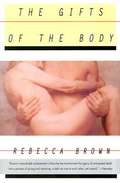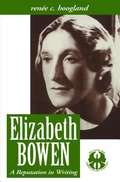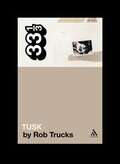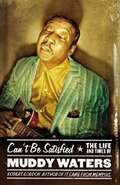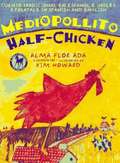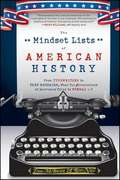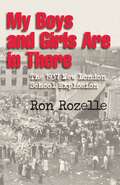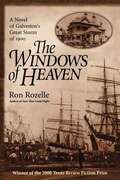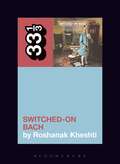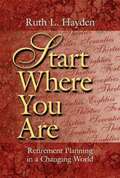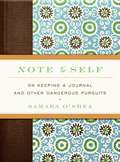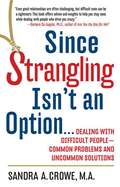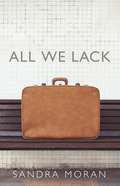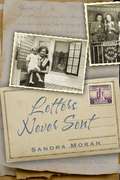- Table View
- List View
The Gifts of the Body
by Rebecca BrownA woman volunteer who cares for people with AIDS narrates a poignant account of the clients she comes to love in her role as a home-care aide, in a bittersweet novel about life, illness, death, and remembrance. By the author of The Children's Crusade.
Lesbian Rabbis: The First Generation
by Rebecca T. Alpert Shirley Idelson Sue Levi ElwellStories of eighteen lesbian rabbis.
Elizabeth Bowen: A Reputation in Writing
by Renee C. HooglandImmensely popular during her lifetime, the Anglo-Irish writer Elizabeth Bowen (1899-1973) has since been treated as a peripheral figure on the literary map. If only in view of her prolific output--ten novels, nearly eighty short stories, and a substantial body of non- fiction--Bowen is a noteworthy novelist. The radical quality of her work, however, renders her an exceptional one. Surfacing in both subject matter and style, her fictions harbor a subversive potential which has hitherto gone unnoticed. Using a wide range of critical theories-from semiotics to psychoanalysis, from narratology to deconstruction-this book presents a radical re-reading of a selection of Bowen's novels from a lesbian feminist perspective. Taking into account both cultural contexts and the author's non-fictional writings, the book's main focus is on configurations of gender and sexuality. Bowen's fiction constitutes an exploration of the unstable and destabilizing effects of sexuality in the interdependent processes of subjectivity and what she herself referred to as so-called reality.
Who Wrote The Bible
by Richard Elliott Friedman"Richard Elliott Friedman focuses on the central books of the Old Testament--Genesis, Exodus, Leviticus, Numbers, and Deuteronomy--and makes a persuasive argument for the identities of their four different authors. Drawing upon the most recent archeological discoveries, Friedman presents a vivid picture of the world of the Bible as he examines where and when these writers lived, the politics and history embedded in their stories, and their relationship to the events they describe and to one another. Challenging many conventional theories of biblical scholarship, he also sheds light on the marvel of the Bible's synthesis, on how the various documents were brought together to form a single text. Who Wrote the Bible? enriches our understanding of the Bible as literature, as history, and as sacred text, and is indispensable for anyone who loves and reads the Good Book."
Ten Basic Responsibilities of Nonprofit Boards
by Richard T. IngramBoardSource's all-time bestseller, this book not only explores the board's 10 core responsibilities, it also puts them into the context of the governance challenges facing nonprofits today. The book clarifies and distinguishes the board's responsibilities from those of the chief executive and senior staff. In addition, it includes two appendixes, one covering the individual responsibilities of board members and the other providing a sample self-assessment for individual board members.
Fleetwood Mac's Tusk (33 1/3 Ser. #77)
by Rob TrucksAfter Rumours became the best-selling single album of all-time, Fleetwood Mac asked Warner Brothers Records to buy them a studio (the label refused, costing both Warner Brothers and the band significant cash in the long run) and then handed the reins to their guitarist and resident perfectionist Lindsey Buckingham, a fusion of factors that led Tusk to become the first record in history to cross the million dollar threshold in production costs. “You know,” Buckingham told me, “we had this ridiculous success with Rumours. And at some point, at least in my perception, the success of that detached from the music, and it was more about the phenomenon. We were poised to do another album, and I guess because the axiom 'If it works, run it into the ground’ was prevalent then, we were probably poised to do Rumours II. I don’t know how you do that, but somehow my light bulb that went off was, ‘Let’s just not do that. Let’s very pointedly not do that.’” Here, Rob Trucks talks to Lindsey Buckingham, as well as members of Animal Collective, Camper Van Beethoven, the New Pornographers, Wolf Parade, the Fleetwood Mac tribute band. Tusk, and the USC Trojan marching band in order to chart both the story and the impact of an album born of personal obsession and a stubborn unwillingness to compromise.
The Mystery of the Whispering Mummy (Three Investigators #3)
by Robert ArthurThe Three Investigators undertake a case involving an Egyptian mummy which whispers, but only to one man.
A Deed of Death: The Story Behind the Unsolved Murder of Hollywood Director William Desmond Taylor
by Robert GirouxWell-born but disinherited Anglo-Irish actor and one-time Yukon prospector, William Desmond Taylor was a prominent Paramount movie director at the time of his unsolved murder in 1922. Suspects included his secretary Edward Sands, a thief and forger; Henry Peavey, his homosexual black cook; and two flamboyant screen stars: drug-addicted Mabel Normand, whom he loved; and 20-year-old Mary Miles Minter, who yearned to be his mistress. In a meticulous probe that reads like a detective thriller, editor-publisher Giroux ( The Book Known as Q ) makes a strong case that the murderer was a contract killer. He shows that Normand had incurred the wrath of dope peddlers, as did Taylor when he attempted to help her break her addiction. Brimming with details of Hollywood's silent era and its rampant post-WW I drug culture, this procedural offers glimpses of Mary Pickford, Charlie Chaplin, Sam Goldwyn, Mack Sennett, Fatty Arbuckle. Illustrations. Copyright 1990 Reed Business Information, Inc.
Can't Be Satisfied: The Life And Times Of Muddy Waters
by Robert GordonThe definitive biography of the most influential blues musician of them all. In a nutshell: no Muddy Waters, no Rolling Stones. ‘Can’t Be Satisfied is that rare thing in musical biographies: a book that maps out not just a single, extraordinary life but the cultural forces that shaped it.
Heroes and Orators
by Robert PhelpsAgainst the background of studied urbanity in an art colony in the Catskills is developed the progression into emotional bankruptcy of three lives, recorded by Roger Becket, a watcher, involved beyond his willingness. After Mark's death, his twenty-year-old wife, Elizabeth, leaves the Pennsylvania university town where her husband taught, to live in Highkill with Margot, Mark's first wife, a commercial artist. Elizabeth is a beautiful, willful, intriguing creature, fascinated by her own perversities and fascinating to Margot who loves her but is ashamed of her feelings, to Roger who, unsure of his own role and responsibilities is afraid of her, and to Gib, who sees her as another in a long line of bedfellows. Mark's death has been for Roger the beginning of his self-realization through the relationships which it thrust upon him.
Sisterhood is Powerful: An Anthology of Writings from the Women’s Liberation Movement
by Robin MorganPublished in 1970, this was the first comprehensive collection of writings from the "Women's Liberation Movement" in the United States, including articles, poems, photographs, and manifestos. It is the precursor to Sisterhood Is Global: The International Women's Movement Anthology (1984), and Sisterhood Is Forever: The Women's Anthology for a New Millennium (2003)
The Champion of Merrimack County
by Roger DruryThe discovery of a bike-riding mouse in the bathtub is just the beginning of a series of humorous communications for the Berryfield family.
The Mindset Lists of American History: From Typewriters to Text Messages, What Ten Generations of Americans Think Is Normal
by Tom Mcbride Ron NiefSnapshots of the U. S. 's last nine generations--from the creators of the Mindset List media sensation Just as high school graduates in 1957 couldn't imagine life without zippers, those of 2009 can't imagine having to enter phone booths and deposit coins in order to call someone from the street corner. Every August, the Mindset List highlights the cultural touchstones that have shaped the lives of that year's incoming college class. Now this fascinating book extends the Mindset List approach to dramatize what it was like to grow up for every American generation since 1880, showcasing the remarkable changes in what Americans have considered "normal" about the world around them. Expands Tom McBride and Ron Nief's popular annual Mindset Lists to explore the mindset of nine generations of Americans, from 1880 to the future high school graduates of 2030 Offers a novel and absorbing way to understand the frame of reference of Americans through history, whether it's the high school grads of 1918, who viewed riding an elevator as a thrill second only to roller coasters, or those of 2009, who have always thought of "friend" as an active verb Puts a human face on the evolution of historical changes related to technology, the struggle for rights and equality, the calamities of war and depression, and other areas The annual Mindset List garners extensive media attention, including on Today, The Early Show, the NBC Nightly News, CNN, and Fox as well as in the Wall Street Journal, the New York Times, USA Today, the Los Angeles Times, Time magazine, and hundreds of international publications Whatever your own generational mindset, this book will give you an entertaining and important new tool for understanding the unique perspective and experience of Americans over more than a hundred and fifty years.
My Boys and Girls Are in There: The 1937 New London School Explosion
by Ron RozelleOn March 18, 1937, a spark ignited a vast pool of natural gas that had collected beneath the school building in New London, a tiny community in East Texas. The resulting explosion leveled the four-year-old structure and resulted in a death toll of more than three hundred—most of them children. To this day, it is the worst school disaster in the history of the United States. The tragedy and its aftermath were the first big stories covered by Walter Cronkite, then a young wire service reporter stationed in Dallas. He would later say that no war story he ever covered—during World War II or Vietnam—was as heart-wrenching. In the weeks following the tragedy, a factfinding committee sought to determine who was to blame. What soon became apparent was that the New London school district had, with almost all local businesses and residents, tapped into pipelines carrying unrefined gas from the plentiful oil fields of the area. It was technically illegal, but natural gas was in abundance in the “Oil Patch.” The jerry-rigged conduits leaked the odorless “green” gas that would destroy the school. A long-term effect of the disaster was the shared guilt experienced—for the rest of their lives—by most of the survivors. There is, perhaps, not a better example than Bill Thompson, who was in his fifth grade English class and “in the mood to flirt” with Billie Sue Hall, who was sitting two seats away. Thompson asked another girl to trade seats with him. She agreed—and was killed in the explosion, while Thompson and Hall both survived and lived long lives, never quite coming to terms with their good fortune. My Boys and Girls Are in There: The 1937 New London School Explosion is a meticulous, candid account by veteran educator and experienced author Ron Rozelle. Unfolding with the narrative pace of a novel, the story woven by Rozelle combines the anguished words of eyewitnesses with telling details from the historical and legal record. Released to coincide with the seventy- fifth anniversary of the New London School disaster, My Boys and Girls Are in There paints an intensely human portrait of this horrific event.
The Windows of Heaven: A Novel of Galveston's Great Storm of 1900
by Ron RozelleSet in Galveston during the 1900 storm, the most devastating natural disaster in the history of the United States, this sweeping novel follows the fates of several richly drawn characters. It is the story of Sal, the little girl who is wise beyond her years and who holds out as much hope for the world as she does for her father, the ruined son of a respected father. It is the story of Sister Zilphia, the nun who helps run the St. Mary's Orphanage. The only thing separating the two long buildings of the orphanage is a fragile line of sand dunes; the only thing separating Zilphia from the world is the brittle faith that she has been sent there to consider. A faith that has never been truly tested. Until now. And it is the story of Galveston herself, the grand old lady of the Gulf Coast, with her harbor filled with ships from the world over; her Victorian homes and her brothels and her grand pavilions set in their own parks; and her stately mansions along Broadway, the highest ground on the island, at eight feet above sea level. All must face their darkest night now, as nature hurls the worst she can muster at the narrow strip of sand and saltgrass that is doomed to become, for a time, part of the ocean floor. This is the story of heroes and villains, of courage and sacrifice and, most of all, of people trying desperately to survive. And it is the story of an era now gone, of splendor and injustice, filled with the simple joy of living.
Wendy Carlos's Switched-on Bach (33 1/3 Ser. #141)
by Roshanak KheshtiSo much, popular and scholarly, has been written about the synthesizer, Bob Moog, and his brand-name instrument-and even Wendy Carlos, the musician who made this instrument famous. No one, however, has examined the importance of spy technology, the Cold War, and gender to this critically important innovation. What is the relationship between synthesizers, electronic music, and world politics? These unlikely correlations form the backdrop to Roshanak Kheshti's inquiry into Wendy Carlos's award-winning album. Through a postcolonial, feminist science and technology studies perspective, Kheshti explores the importance of Carlos's first album to synthesizer technology, home studio design, and sound color orchestration. She further examines the jockeying among world powers for status within an electronic music race akin to the Space Race of the same era. By focusing on Switched-On Bach (the highest-selling classical music recording of all time), this book examines the gendering of sound over the course of the twentieth century. Roshanak Kheshi is Associate Professor of Ethnic Studies and affiliate faculty in the Critical Gender Studies Program at the University of California, San Diego, USA.
Start Where You Are: Retirement Planning in a Changing World
by Ruth L. HaydenStart where You Are is a delight to read. It’s like sitting down with Ruth and carrying on a warm, lively conversation about ways to transform dreams into reality and bring balance into life, and to take control of our finances. Ruth offers plenty of sensible, no nonsense advice for managing money through the ages. But her passion is helping you create a vision and a realistic plan for achieving the kind of life you want, especially during your later years. Do you want to start mapping out your blueprint for a good retirement? Then I highly recommend Start Where You Are. Chris Farrell, host of Public Television’s Right on the Money and Public Radio’s Sound Money Far from another personal finance tome, Ruth Hayden's book is an inspiring and highly entertaining guide to planning for the rest of your life, however long that may be. While it offers clear guidance in terms of helping readers understand how much money they’ll need in retirement and how to make it last, it goes far beyond that—provoking us to think about what we really want for our lives. The real-life stories she relates make this a very readable hook. Gerri Detweiler, consumer advocate and author of The Ultimate Credit Handbook
For The Love Of Letters: A 21st-Century Guide to the Art of Letter-Writing
by Samara O'SheaThis book covers everything from love letters to apology, thank you and the standard business letters, including recommendation and resignation letters. An interesting and entertaining read.
Note to Self: On Keeping a Journal and Other Dangerous Pursuits
by Samara O'SheaKeeping a journal is easy. Keeping a life-altering, soul-enlightening journal, however, is not. At its best, journaling can be among the most transformative of experiences, but you can only get there by learning how to express yourself fully and openly. Enter Samara O'Shea. O'Shea charmed readers with her elegant and witty For the Love of Letters. Now, in Note to Self, she's back to guide us through the fun, effective, and revelatory process of journaling. Along the way, selections from O'Shea's own journals demonstrate what a journal should be: a tool to access inner strengths, uncover unknown passions, face uncertain realities, and get to the center of self. To help create an effective journal, O'Shea provides multiple suggestions and exercises, including: Write in a stream of consciousness: Forget everything you ever learned about writing and just write. Let it all out: the good, bad, mad, angry, boring, and ugly. Ask yourself questions: What do I want to change about myself? What would I never change about myself? Copy quotes: Other people's words can help you figure out where you are in life, or where you'd like to be. It takes time: Don't lose faith if you don't immediately feel better after writing in your journal. Think of each entry as part of a collection that will eventually reveal its meaning to you. O'Shea's own journal entries reveal alternately moving, edgy, and hilarious stories from throughout her life, as she hits the party scene in New York, poses naked as an aspiring model, stands by as her boyfriend discovers an infidelity by (you guessed it) reading her journal, and more. There are also fascinating journal entries of notorious diarists, such as John Wilkes Booth, Anaïs Nin, and Sylvia Plath. A tribute to the healing and reflective power of the written word, Note to Self demonstrates that sometimes being completely honest with yourself is the most dangerous and rewarding pursuit of all.
Since Strangling Isn't an Option: Common Problems and Uncommon Solutions
by Sandra A. CroweDo certain people have you gritting your teeth, biting your tongue, and (metaphorically, at least) banging your head against the wall? Do you feel like you're expending too much energy either engaging in conflict or desperately trying to avoid it? There really are better, easier ways to deal with difficult people. This refreshing, realistic guide, with revealing selfquizzes and engaging exercises included, will provide you with real solutions to the oftentimes "unreal" problems. YOU'LL LEARN ABOUT ... · why dealing with a difficult person doesn't have to ruin your day · the habits that cause continued conflict-and the techniques that can turn things around · how developing an "attitude of gratitude" helps smooth the way · your own power in shaping relationships (it can make a bigger difference than you think!) · snakes and lizards, donkeys and hyenas: specific advice for specific personality types With mindfulness, compassion, and common sense, it is possible to deal successfully with difficult people. And with enough practice of the principles in this book-and a healthy dose of patience-you might even get to like them. "Dealing with difficult people is an unavoidable fact of life in our fast-moving, competitive society. This book shows you how to defuse the negative aspects of another's behavior and be more effective in every situation." -Brian Tracy, author of Maximum Achievement
All We Lack
by Sandra MoranIt begins with a bus crash. Maggie is a funeral director from Indiana who lives a double life. Bug is a ten-year-old boy in the Pennsylvania foster care system who is sent to live with an aunt he doesn't know. Jimmy is a former paramedic and prescription drug addict on his way to meet a woman he met online who thinks he's a successful doctor. Helen is a Chicago insurance investigator who is leaving her marriage in search of the woman she wants to be. Four strangers, all traveling to Boston in search of better lives, are tied together in ways they don't even realize. Each are trying to fill the void of what's missing in their lives. Sometimes it takes a tragedy to overcome all that we lack.
Letters Never Sent
by Sandra MoranThree women, united by love and kinship, struggle to conform to the social norms of the times in which they lived. In 1931, Katherine Henderson leaves behind her small town in Kansas and the marriage proposal of a local boy to live on her own and work at the Sears & Roebuck glove counter in Chicago. There she meets Annie--a bold, outspoken feminist who challenges Katherine's idea of who she thinks she is and what she thinks she wants in life. In 1997, Katherine's daughter, Joan, travels to Lawrence, Kansas, to clean out her estranged mother's house. In an old suitcase she finds a wooden box containing trinkets and a packet of sealed letters to a person identified only by a first initial. Joan reads the unsent letters and discovers a woman completely different from the aloof and unyielding mother of her youth--a woman who had loved deeply and lost that love to circumstances beyond her control. Now Joan just has to find the strength to use the healing power of empathy and forgiveness to live the life she's always wanted to live.
